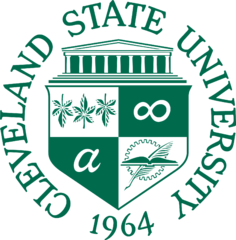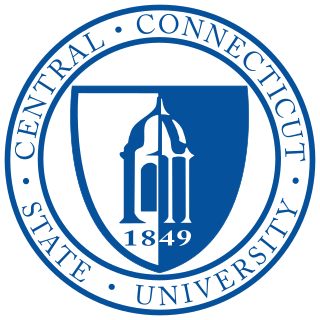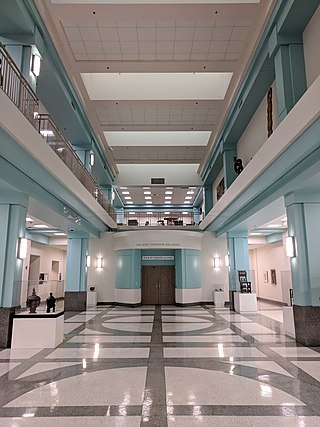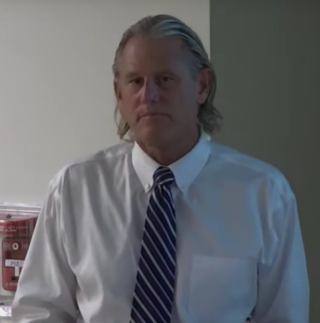
The California State University is a public university system in California, and the largest public university system in the United States. It consists of 23 campuses and seven off-campus centers, which together enroll 457,992 students and employ 56,256 faculty and staff members. In California, it is one of the three public higher education systems, along with the University of California and the California Community Colleges systems. The CSU system is officially incorporated as The Trustees of the California State University, and is headquartered in Long Beach, California.

The Universities of Wisconsin is a university system of public universities in the U.S. state of Wisconsin. It is one of the largest public higher-education systems in the country, enrolling more than 160,000 students each year and employing approximately 41,000 faculty and staff statewide. The system is headquartered in the state capital of Madison.

Cleveland State University (CSU) is a public research university in Cleveland, Ohio, United States. It was established in 1964 and opened for classes in 1965 after acquiring the entirety of Fenn College, a private school that had been in operation since 1923. CSU absorbed the Cleveland-Marshall School of Law in 1969. Today it is part of the University System of Ohio, has more than 120,000 alumni, and offers over 200 academic programs amongst eight colleges. It is classified among "R2: Doctoral Universities – High research activity".
The University System of Maryland (USM) is a public university system in the U.S. state of Maryland. The system is composed of the eleven campuses at College Park, Baltimore County, Baltimore, Princess Anne, Towson, Salisbury, Bowie, Frostburg, Hagerstown, Rockville, Cambridge, and Adelphi, along with four regional higher education centers located throughout the state.

Central Connecticut State University is a public university in New Britain, Connecticut. Founded in 1849 as the State Normal School, CCSU is Connecticut's oldest publicly-funded university. It is made up of four schools: the Ammon College of Liberal Arts and Social Sciences; the School of Business; the School of Education and Professional Studies; and the School of Engineering, Science, and Technology. As of Spring 2022, the university was attended by 8,898 students: 7,054 undergraduate students and 1,844 graduate students. More than half of students live off campus and 96 percent are Connecticut residents. The school is part of the Connecticut State Colleges & Universities system (CSCU), which also oversees Eastern, Western, and Southern Connecticut State Universities.

Charter Oak State College is a public online college based in New Britain, Connecticut. The college was founded in 1973 by the Connecticut Legislature and offers associate, bachelor's, and master's degrees. The college is adjacent to Central Connecticut State University and is named for Connecticut's famous Charter Oak.

The University of Alaska System is a system of public universities in the U.S. state of Alaska. It was created in 1917 and comprises three separately accredited universities on 19 campuses. The system serves nearly 30,000 full- and part-time students and offers 400 unique degree programs.

The Minnesota State Colleges and Universities system or Minnesota State, previously branded as MnSCU, comprises 26 state colleges and 7 state universities with 54 campuses throughout Minnesota. The system is the largest higher education system in Minnesota and the third largest in the United States, educating more than 300,000 students annually. It is governed by a 15-member board of trustees appointed by the governor, which has broad authority to run the system. The Minnesota State system office is located in the Wells Fargo Place building in Saint Paul, Minnesota.

Minnesota State University, Mankato is a public university in Mankato, Minnesota, United States. It is Minnesota's second-largest university and has over 145,000 living alumni worldwide. Founded in 1868, it is the second-oldest member of the Minnesota State Colleges and Universities system and is commonly referred to as the flagship institution. It was established as the Second State Normal School in 1858 and officially opened as Mankato Normal School a decade later. Minnesota State University, Mankato is a significant contributor to the local and state economies, adding $827 million annually.
The State University System of Florida is a system of twelve public universities in the U.S. state of Florida. As of 2018, over 341,000 students were enrolled in Florida's state universities. Together with the Florida College System, which includes Florida's 28 community colleges and state colleges, it is part of Florida's system of public higher education. The system, headquartered in Tallahassee, is overseen by a chancellor and governed by the Florida Board of Governors.

California State University Channel Islands is a public university in Ventura County, California. Located near the city of Camarillo, it opened in 2002 as the 23rd campus in the California State University system. CSUCI is located on the Central Coast of California, at the intersection of the Oxnard Plain and northernmost edge of the Santa Monica Mountains range. The Channel Islands are nearby where the university operates a scientific research station on Santa Rosa Island.
In the United States, a board often governs institutions of higher education, including private universities, state universities, and community colleges. In each US state, such boards may govern either the state university system, individual colleges and universities, or both. In general, they operate as a board of directors, and they vary by formal name, size, powers, and membership. In some states, members are appointed by the governor.
The California Master Plan for Higher Education of 1960 was developed by a survey team appointed by the Regents of the University of California and the California State Board of Education during the administration of Governor Pat Brown. UC President Clark Kerr was a key figure in its development. The Plan set up a coherent system for public postsecondary education which defined specific roles for the already-existing University of California (UC), the state colleges which were joined together by the Plan into the State College System of California and later renamed the California State University (CSU), and the junior colleges which were later organized in 1967 into the California Community Colleges (CCC) system.

Housatonic Community College (HCC) was a public community college in Bridgeport, Connecticut. It part of the Connecticut State Colleges & Universities system. HCC grants associate degrees and also has certificate programs. In July 2023, it became Connecticut State Community College Housatonic, as part of a merger of twelve institutions.

The Oklahoma State Regents for Higher Education is the agency of the government of Oklahoma that serves as the governing body of the Oklahoma State System of Higher Education, which is the largest provider of higher education in the state of Oklahoma. The State System consists of all institutions of higher education in Oklahoma that are supported by direct legislative appropriations from the Oklahoma Legislature.

The Association of Governing Boards of Universities and Colleges (AGB) is a nonprofit 501(c)(3) U.S. higher education association established in 1921. AGB serves approximately 2,000 colleges, universities, and institutionally related foundations. The association provides research, publications, programming, and consulting services to support higher education governance. AGB is located in Washington, D.C.
The Board of Regents for Higher Education (BOR) is a government body in the U.S. state of Connecticut that oversees the Connecticut State Colleges & Universities (CSCU). CSCU and the BOR were created on July 1, 2011, consolidating the governance of the state's twelve community colleges, four state universities, and Charter Oak State College. The BOR assumed the powers and responsibilities of the respective former Boards of Trustees and the Board for State Academic Awards; it also retains many responsibilities for setting statewide policy of the former Board of Governors for Higher Education.

Kevin Witkos is a Republican member of the Connecticut State Senate, representing the 8th District since 2009. He served as Deputy Senate Republican President Pro Tempore since January 2017 to January 2019. and previously served as Minority Leader Pro Tempore from 2014 to 2016 and Caucus Chairman for Outreach since 2013. Witkos served as the State Representative from the 17th district which includes Canton and part of Avon from 2003 to 2008.
Richard J. Balducci is a retired lobbyist and politician from Newington, Connecticut who was the Speaker of the Connecticut House of Representatives from 1989 to 1992. He also served one term in the Connecticut State Senate.
Connecticut State Community College was formed on July 1, 2023, through the merger of all of the twelve community colleges in the state of Connecticut. The public and comprehensive multi-campus community college headquartered in New Britain, Connecticut. Founded in 2023 as the result of the merger of Connecticut’s 12 legacy community colleges.














